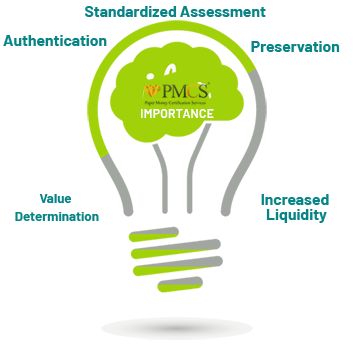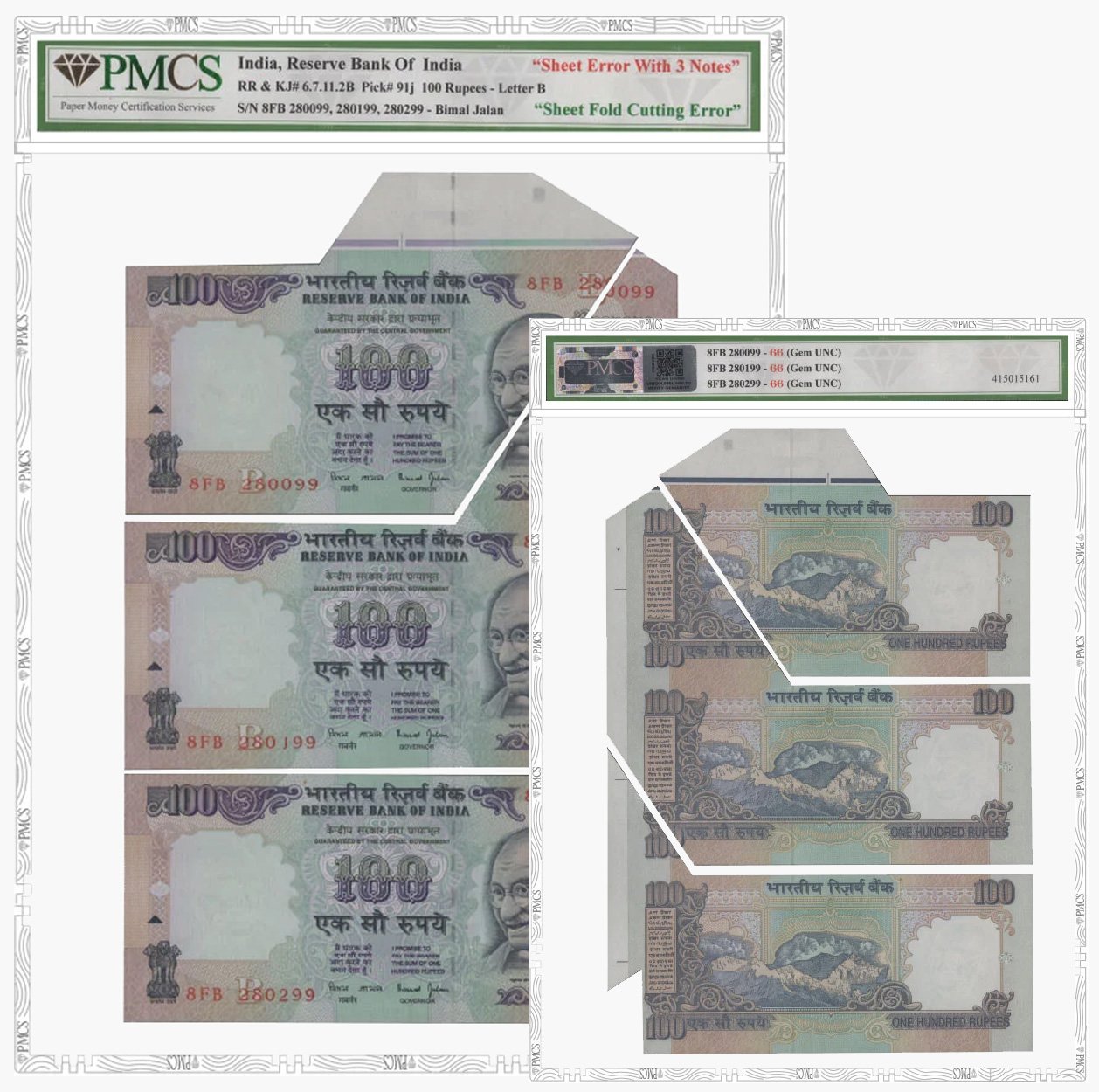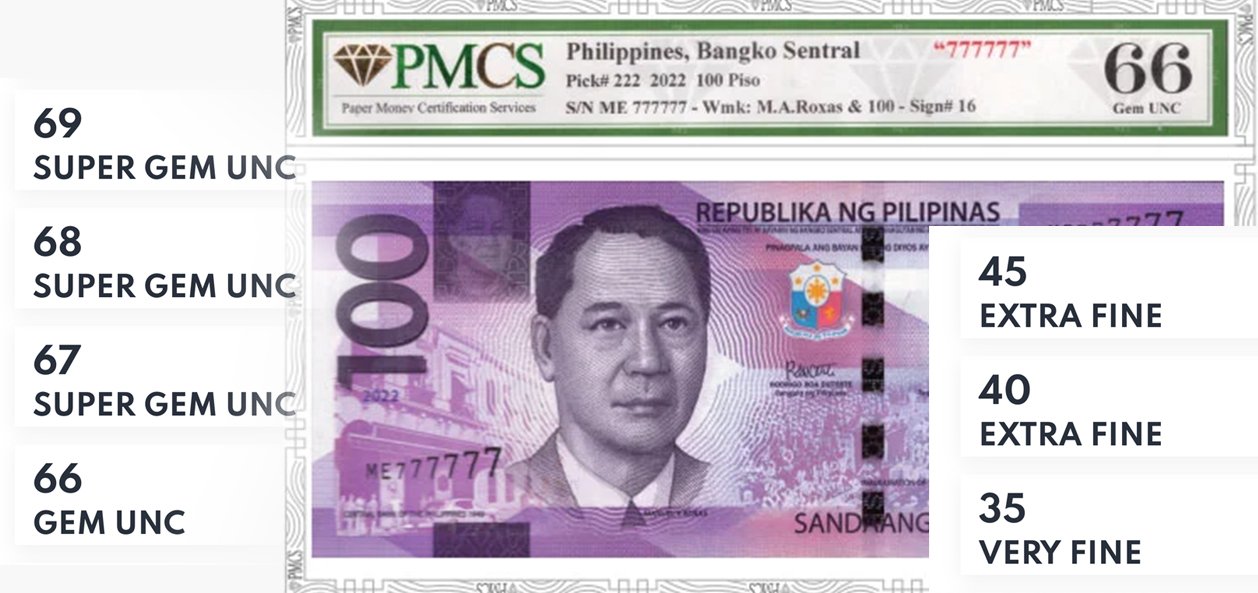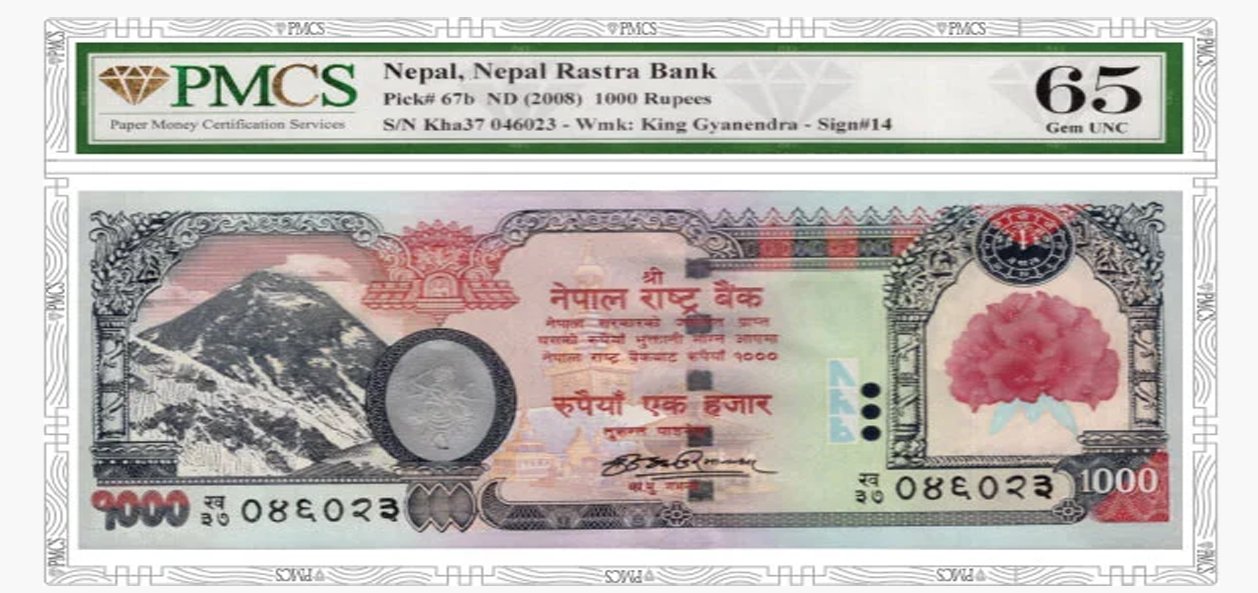The PMCS Banknote Grading Scale:
A Comprehensive Guide to Determining Condition and Value
Understanding the 70Point Numerical Scale: A Foundation for
Accurate Banknote Valuation
At PMCS, we are committed to providing transparent, accurate, and
reliable banknote grading services. A critical aspect of our service is the application
of the International 70Point Numerical Grading Scale, a widely recognized standard for
assessing the condition and value of banknotes. This guide provides a detailed
explanation of the scale, our grading criteria, and how the grading process works at
PMCS.
A grading scale is a systematic index used to determine the age and
condition of circulated banknotes, a critical factor that prompts its value. The
International 70Point Grading scale was first established in the 1940s in the US. Today,
there are many modifications to the scale followed to suit the type of paper money used
in different countries.
The Importance of Banknote Grading: Preserving Value and
Fostering Trust

Banknote grading plays a crucial role in the world of numismatics,
serving as a
standardized
method for evaluating the condition and authenticity of paper money. Accurate grading
provides
several key benefits:
- Standardized Assessment: The
70-point
scale offers a consistent and objective way to
assess a banknote's condition, reducing subjectivity and promoting fair market
practices.
- Value Determination: The grade
assigned to
a banknote directly impacts its value. Higher
grades generally command premium prices, reflecting the scarcity and desirability of
well-
preserved examples.
- Authentication: The grading
process
involves a thorough authentication review, protecting
collectors and investors from counterfeit notes.
- Preservation: Encapsulation in a
tamper-evident holder safeguards the banknote from
environmental damage, handling, and other factors that can degrade its condition
over time.
- Increased Liquidity: Certified and
graded
banknotes are easier to buy and sell, as they
provide potential buyers with confidence in the note's authenticity and condition.
The PMCS Grading Philosophy: Accuracy, Transparency, and
Expertise
At PMCS, we adhere to the highest standards of accuracy and
transparency in our grading
process. Our team of experienced numismatists combines expert knowledge with
cutting-edge
technology to ensure that every banknote receives a thorough and unbiased
evaluation.
Key Factors Evaluated During
Grading:
The PMCS grading criteria include the close analysis of the folding, handling marks,
color
quality,
margins, folds, and corner tips of the paper money. This comprehensive evaluation
process is
performed and assign the appropriate grade, by our team of experienced numismatists.
- Centering: The position of the
printed
design on the paper. Well-centered notes are more
visually appealing and generally receive higher grades.
- Margins: The amount of blank paper
surrounding the printed design. Notes with wide, even
margins are more desirable.
- Paper Quality: The overall
condition of
the paper, including its crispness, color, and
presence of any defects.
- Printing Quality: The sharpness,
clarity,
vibrancy and integrity of the printed design.
- Handling: The degree of wear and
tear
resulting from handling, including folds, creases,
wrinkles, and corner rounding.
- Damage: Any physical damage to the
note,
such as tears, stains, holes, or repairs.
- Eye Appeal: The overall visual
appeal of
the note, taking into account all of the above
factors.

Deciphering the 70Point Grading Scale: A Detailed Breakdown
of Each Grade
The International 70Point Grading Scale is a numerical system for evaluating a banknote's
physical condition. The higher the number, the better the condition of the banknote. The range
of grades is different depending on the source you consult, but in general the ranges that PMCS
follows are :
In essence, the “70” grade is a perfectly faultless note. It will be an original
specimen possessing all four margins that are broad and absolutely even, containing
sharp corners, vivid colors, marvelous eye appeal, and literally perfect paper
quality with no hint of any fault whatsoever. It is possible that only the most
modern, just-printed notes will accomplish this grade, and even then it will be
extremely rare.
To the unaided eye and at first glimpse, this note appears to be as faultless as the
New 70 with absolutely no handling. However, after careful inspection under 5x
magnification, minor blemishes are visible. These might be that margins are minutely
off center and traces of some minute handling imperfections e.g. crinkling of the
note.
This note as good as and closely resembles the 69. Nevertheless, there are slightly
more noticeable handling issues in this than in the 69. Some minor flaws are visible
to the unaided eye. These are slightly off-center margins, a tiny wrinkle on the
paper, a mark obtained while packaging and/or an inadvertent ink stain.
This constitutes the highest grade possible for most note series. It contains broad
margins though the centering is a bit off-center, minor handling marks and tiny
flaws but these seem well above average to the naked eye.
Again, here too, the centering of the note will be above average…in fact, it is of
better-quality to an average note. Basically, if the rest of the banknote is without
any major blemish, but with ample tighter margins – these are acceptable. And, there
will be indication of a little more handling than the 67.
At a cursory glance, the faults and blemishes on this note do not distract from its
visual appeal. It is a great quality banknote displaying obvious and many
imperfections pertaining to crinkles, bent edges, stains from fingers and minor
corner roundingʼs obtained due to repeated counting, The above average centering
permit this note to be well received if its margins are broad. Even if carving and
designing are present, this note will not attain the Paper Quality level if its
originality cannot be decided. Alternatively, a Superb note without any embossing or
one that is pressed flat or without any folds or bends may obtain a 65 grade.
In these notes, the centering is definitely off on both sides of the note.
Additionally, some or all corners may have folds or have lost their sharpness.
Considerable handling can be noticed immediately. This is evident showcasing
problems of packing and frequent counting that has resulted in minor folds in
corners but which does not enter the design of the note.
This is a new note without any folds or bends, thus indicating little or no
circulation Quality of paper and eye appeal will be above average. There may be one
or two folds in the note. However, crinkles due to counting or other handling marks
such as pinching and frayed corners are generally acceptable, but these are not
present in the design of the note, which effectively means that the note should not
contain these minor defects along the full span of the note. Besides, a couple of
pinholes may also be present in the note. This grade is given to notes that
originally appear of Gem New quality but consist of flat surfaces.
The centering in this note is completely off. Several blemishes make it an out of
choice category. Corners will not be smooth containing severe bruising and creasing.
Partial bending and folding is likely. If there is any fold in the entire span of
the note, it will not be classified in this category.
Notes that consist of a combination of faults are in this group. Some of the faults
may be severe e.g. paper toning, handling and counting marks, smears of ink,
pinholes, and corner folds that do not reach the design. It will also be poorly
centered. All these prevent it from reaching a higher grade.
This is usually an unattractive note. Similar problems that occur in the
Uncirculated 62 and New 61 are present in this note but with more severity. These
may include loss of colour, paper toning, minor foxing, flat and inert paper,
pinholes and small staining spots.
This represents a note with a single fold at the center that goes right across the
design. Other details that assist in grading this note are clear folds in the corner
or with worn edges, clearly indicating that it has been well circulated.
This is easy to detect as it will have one central fold and more than one corner
fold. All these folds will enter the design.
A note that is of an intermediate grade above the 50 but does not quite reach the
55; this note will have at least one heavy groove or fold. However, it may include
all the other qualities of an uncirculated note. Or, it might contain corner folds
and light bends that do not allow it from reaching a higher grade.
Any note that has a distinctly heavy and damaged center fold as well as two moderate
vertical folds will be categorized here. The note can also contain a horizontal or
vertical fold with heavy corner folds. Anything heavier than moderate and the note
will be considered at a lower level.
This note is vivid, clean, crisp and eye-catching containing a few light folds or
many light bends. Above average eye appeal is present but with a visibility of
slight soiling. Additionally, there may be a few light folds or several tiny bends
or a couple of vertical creases,
It is essentially a note of a lower category than the Extremely Fine 45 with three
or more folds, one of which may be horizontal. It may also contain some light bends
or pinholes that are not overly conspicuous and proceed to distract from the design.
This grade of note marginally misses the Extremely Fine 40 grade due to its
additional light folds; about 5 to 7 of them. It has great eye appeal and is above
average for a Very Fine note.
A note that has been circulated lightly and therefore, consists of a bit of soiling.
The paper is bright, retains its colour and the note must be crisp to touch. This
grade note have 8 to 10 folds.
This is basically a note with primarily bright and solid paper with some signs of
light handling and soiling due to its circulation. These mutilations of heavier
staining and toning through heavy folds have resulted in the paper losing its
crispness.
Beginning to show obvious signs of circulation with numerous folds , worn and folded
corners, this note has just enough body to prevent it from being categorised an VF
15. If the note is held against the light, one can see several pinholes; the corners
are frayed or a bit rounded.
This note looks as if of a very fine grade until and unless it is examined closely.
Then, too many folds and a slight splitting resulting from a lot of circulation can
be noticed. Paper quality has also deteriorated a bit.
Spending a lot of time in circulation, this note has rounded corners and edges that
show splitting and fraying.
It is a solid note showing a lot of circulation and due to this, it has become limp.
It also contains a lot of minor problems including heavy staining and many heavy
folds.
A note of this grade is worn extensively and has slightly rounded corners and,
frayed edges as well as margins that are rough including some wallet staining. Due
to the extensive circulation, the note will be limp.
This note has major damages such as heavy wear and tear, a tiny missing piece from
the edge or an internal hole. There could also be a combination of minor damage with
staining.
Basically intact, this note will have its colour fading, no eye appeal and
completely limp. This could be due to very heavy circulation. Some minor pieces of
the note will be missing and this will extend into the design as well.
Why Grading Matters: Enhancing the Value and Security of
Your Banknotes
Professional grading services like PMCS play a crucial role in the
numismatic community,
providing several key benefits to collectors and investors:
- Transparency and Objectivity:
Grading services provide an unbiased assessment of a banknote's condition, reducing
subjectivity and enhancing transparency in the marketplace.
- Increased Value: Grading services
provide an unbiased assessment of a banknote's condition, reducing subjectivity and
enhancing transparency in the marketplace.
- Transparency and Objectivity:
Certified and graded banknotes are generally more valuable than ungraded notes due
to the increased confidence and assurance they provide to potential buyers.
- Improved Liquidity: Graded
banknotes are typically easier to sell than ungraded notes.
- Protection and
Preservation: Encapsulation helps to safeguard against damage from
handling, environmental factors, and tampering.
Submitting Your Banknotes for Grading: A Simplified
Process
At PMCS, we strive to make the submission process as seamless and
user-friendly as
possible.
Whether you're a seasoned collector or a new enthusiast, our team is dedicated to
providing
expert guidance and support throughout every step of the process.
Disclaimer
The guidelines provided on the PMCS website are for informational purposes
only and
should
not be considered the final authority on banknote grading. The final assessment of a
banknote
will be based on information provided by PMCS and will be at its discretion.



